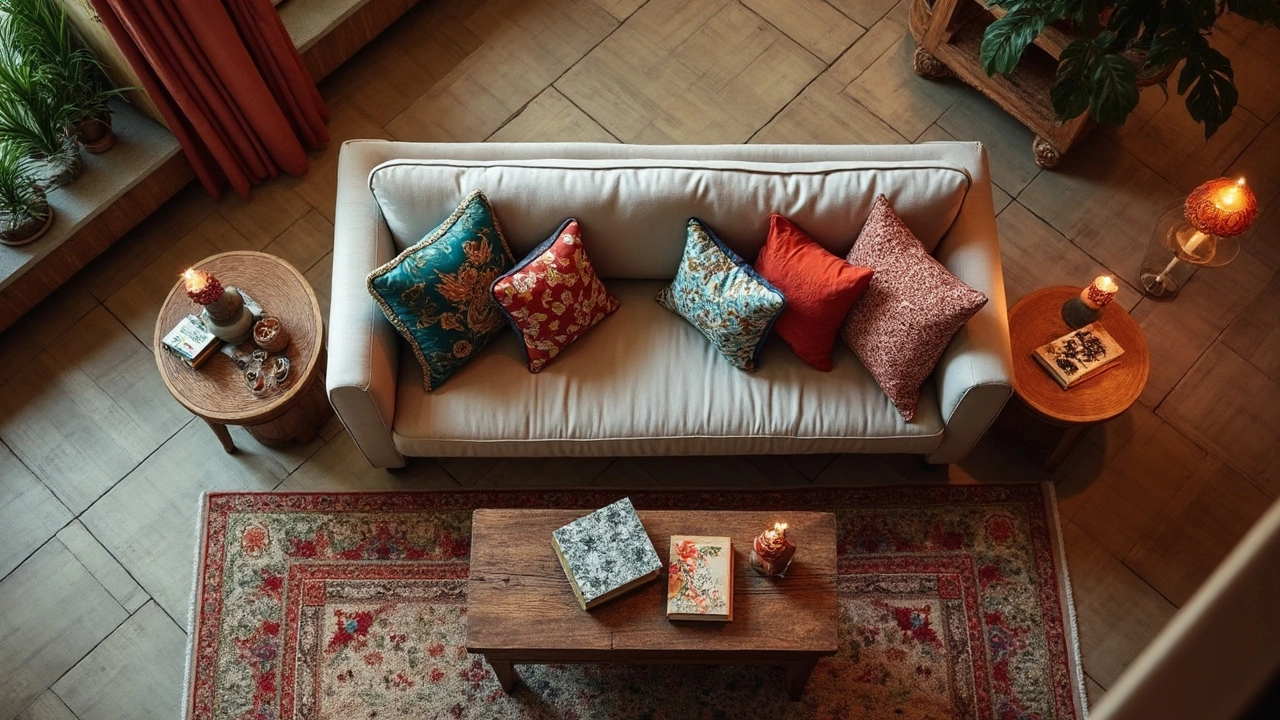Best Cushion Size for Couch: Ultimate Guide to Sofa Comfort and Style

The secret to a cozy, inviting couch isn’t about the brand or even the fabric. It’s about the cushions—the ones you slouch on after a long day, the ones that add color and character, and, honestly, the ones that keep your guests from awkwardly perching on the edge. Ask ten people about the best cushion size for their sofa and you’ll probably get ten totally different answers. So what’s actually ideal? There’s a method to the madness, and it mixes practicality with a little personal flair—and a dash of science.
Why Cushion Size Matters More Than You Think
Most people figure out what’s wrong with their cushions the hard way—by constantly rearranging, buying replacements, or cursing a sore back after a movie marathon. The size of your couch cushions does more than fill empty space: it seriously affects comfort, posture, the perception of your living room, and even the lifespan of your seating. Oddly enough, researchers who studies furniture ergonomics suggest the wrong cushions can actually trigger or worsen back pain. There’s a balance you want to strike here: cushions too big and you feel swallowed alive; too small and you slide off like you’re on a greased ramp.
The typical throw pillow for a standard sofa sits somewhere between 18 and 22 inches square. Yet, the real magic happens when these aren’t an afterthought, but chosen to match your couch’s seat depth and width. If you’ve got a deep, overstuffed couch, 24-inch cushions make more sense; for more compact or mid-century modern sofas, 16- or 18-inch pillows look proportional. A common misstep? Grabbing a mountain of tiny cushions, only to realize there’s no place to actually, you know, sit. Every inch matters—and not just for looks.
Cushion dimensions aren’t the only thing at play. The thickness, firmness, and even pillow fill affect the sense of comfort and “luxury.” Memory foam, goose down, polyfiber—they all affect bounce, squish, and even how the cushions hold their shape after months of Netflix. A 20-inch pillow stuffed firmly feels and sits way bigger than a sagging 24-incher filled with loose polyester. Ever noticed how hotel lobbies always have perky, plump pillows? It’s not by accident.
It’s also wild how cushion size shapes your whole room’s vibe. Go oversized, and the space instantly feels more inviting, casual, warm. Keep ‘em small and tailored, and suddenly your place screams minimalist chic or fuss-free modern. Interior decorators often play with cushion size to trick people’s eyes—either making a tiny couch look bigger or softening the look of a massive sectional. Beyond comfort, your cushion size works like visual magic on your space.
Most Popular Couch Cushion Sizes—And Why They Work
Walk into almost any home store, and you’ll spot three classic cushion sizes: 16x16 inches, 18x18 inches, and 20x20 inches. These aren’t random numbers. Designers settled on these thanks to decades of sofas with typical seat depths, arm heights, and average living rooms. Here’s the deal: smaller sofas and love seats demand slimmer 16- or 18-inch pillows, otherwise you crowd people out or make the couch look “stuffed to the gills.” Larger, modern sectionals and deep sofas love the 22- and even 24-inch square pillows. These big cushions fill out the space, prop you up, and encourage endless lounging without looking dinky.
Besides the plain squares, you’ve probably seen lumbars—rectangular pillows like 12x20 or 14x22 inches. These are lifesavers. Put them behind your lower back and you instantly lift your posture, get better support, and add some eye-level interest with the rectangular profile. On pretty much every design-focused Instagram, you’ll see combos: one or two bigger squares, and a lumbar in front. This set-up looks finished rather than cluttered.
Don’t forget the unsung heroes: bolster pillows. They’re long, round, and perfect for stretching out. Though not as common, one or two bolsters on a large couch scream “lounge-worthy,” and if you like to nap on your side, they’re miracle workers.
For the numbers people: most decorators use 20-inch pillows on sofas with seat depths between 20 and 24 inches. If your couch is deeper (think over 24 inches), step up to 22- or 24-inch cushion throws. Seat height factors in too: taller seat cushions can handle larger throw pillows without them spilling over the edge. Want a fast trick? Aim for pillows that are roughly half to two-thirds the length of your sofa’s depth. Works every time.
Mixing sizes is another neat trick. A three-cushion couch with two 24-inch squares, two 20-inch pillows, and a little lumbar thrown in? It instantly feels layered and curated, not like you just grabbed whatever was on sale. Doubling up on identical size/shape pillows can look nice and neat, but varying sizes adds serious depth and style fast.

How to Pick the Right Cushion Size for Your Couch
So here’s the real question: how do you know what size fits your actual couch, the one in your living room, not a showroom? Start by measuring: grab a tape measure and check both the seat depth (from front edge to backrest) and the seat width (from arm to arm). Write those down. If your couch is short on seat depth, smaller pillows work better, leaving enough room that guests don’t have to perch sideways. If it’s got a deep seat, don’t skimp—those big, pillowy squares are the gateway to proper Sunday lounging.
Next, tweak for comfort and style. Do you want your couch as a crash pad for naps? Go bigger and pick softer fills. Prefer the upright, tidy, “always put-together” look? Smaller, firmer cushions nail that vibe. Mixing is encouraged. You can always put the biggest pillows toward the arms, smallest in the middle or front. Balance things: if your sofa has low arms and a tall back, you can take larger cushions; high-armed, compact couches need slimmer, low-profile throws to avoid a blocky look.
Color and pattern actually influence how the cushion size “reads” visually. Bold, dark cushions appear heavier and larger; light colors recede, seemingly shrinking the pillow. So, if you love a giant 24-inch cushion but don’t want it to dominate, go for a pale, lightweight fabric—it’ll look less intrusive. Patterns distract the eye, making pillows look slightly smaller than their real size, while solid colors emphasize their shape.
Not sure if your choices work? Use the floor test. Stack your intended pillows on the floor, in the same width as your couch seat, and pretend to sit. Too squished? Too wide? Now imagine those on your couch. It’s a fast way to see if you’re overdoing it without buying and returning a dozen options.
One last thing: think about daily life. Do you have kids or pets who toss, smash, and parade the pillows around? Removable, washable covers and cushion sizes that actually fit your wash machine will save your sanity. If you host often, skip pillows so big guests have nowhere to sit. For solo Netflix binging—let your comfort rule and pile them on.
Styling Tips: Mixing and Matching Different Cushion Sizes
Now, here’s where it gets fun—combining different cushion sizes to make your couch feel like it’s straight from a design magazine. Most pros use the “odd numbers” rule. Three or five pillows on the couch looks intentional. Arrange from largest on the outside (toward the arms) to smaller sizes layered in front or toward the center. If you want a perfectly casual look, toss them on without thinking and gently “karate chop” the top for that squished-in-the-middle designer vibe people love.
Try mixing a couple of super-sized squares (22- or 24-inch), medium (20-inch), then a rectangle lumbar or a round bolster. This not only feels lush, it gives levels and breaks up the monotony. Be brave with shapes—throw in one round or cylindrical pillow; you’d be surprised how much it softens the right angles of a classic couch.
Textures and fabrics play a role too. Instead of just changing up color or pattern, swap between velvet, linen, faux fur, or even leather. This subtly signals different sizes and adds some tactile interest (and temptation to pet the pillows absentmindedly). And if you like symmetry: mirror your arrangement on both sides. For a more relaxed, boho vibe, go asymmetrical and keep the larger cushions just on one end for a loungy nook feel.
Don’t sleep on floor pillows, either. If you run out of room on the couch, try a couple of oversized, heavyweight cushions on the floor nearby. They’re kid catnip and perfect for board games, surprise extra seating, or an impromptu nap zone.
If you want to pull together a color scheme with your cushion sizes, stick to one bold color and three related shades in various sizes. This creates a cohesive, high-impact look without feeling chaotic. Layering patterns? Put the biggest, busiest pattern on your largest cushion; tone it down to solids or smaller prints as you move inward or forward in your arrangement. It all comes down to balance—mix big and small, loud and quiet, soft and structured for a look everyone secretly wants.

Real-Life Examples and Fun Facts About Cushions
Here’s something wild: the standard 18-inch throw pillow has been around since the mid-20th century, matching up with classic couch proportions that haven’t changed much since then. Flashback to early Egyptian times, though, and cushions were wooden blocks—imagine trying to binge-watch on those. Now, almost half of American homes have at least five decorative couch pillows, with many owning more. It’s a true love-hate relationship—people fling them on the floor, yet keep buying more in search of “the right one.”
One New York-based designer swears by the “three-two-one” arrangement: three 22-inch squares, two 18-inch, and one lumbar. It’s foolproof, and works on almost any sofa size except a tiny loveseat. For sectionals with a chaise, putting a big 24-inch on the corner and smaller ones along the sides complements the odd shape and fills in dead spots. Got a vintage couch? Smaller pillows match the proportions so the piece looks stylish, not overwhelmed.
People are getting bolder with cushions, too. Oversized 26- and even 28-inch floor pillows are showing up everywhere from college dorms to high-end homes, giving flexible seating. If sustainability’s on your mind, recycled feather-down and memory foam blends are gaining traction. Whatever the fill, invest in a quality insert—cheap ones flatten out faster than you can say "movie night."
If you want your cushions to last, a quick daily "fluff-and-rotate" goes a long way. It keeps the fill from sagging and prevents the dreaded pancake-pillow syndrome. Plus, it helps redistribute the wear. For those with allergies, washable hypoallergenic covers and inserts are a lifesaver—and most modern brands carry at least a few.
So next time you’re eyeing new pillows, look past color. Consider your couch’s size, the vibe you want, and real-life use. Mix and match confidently, shoot for odd numbers, and always measure before you buy. Your back, your guests, and even your Instagram will thank you.